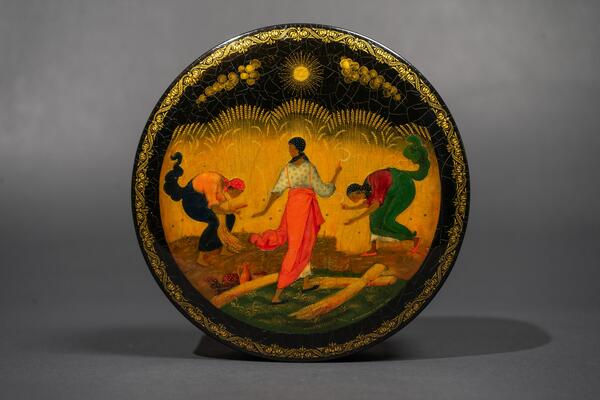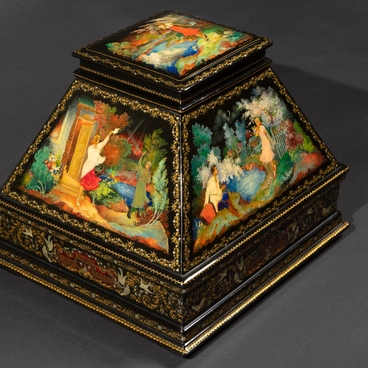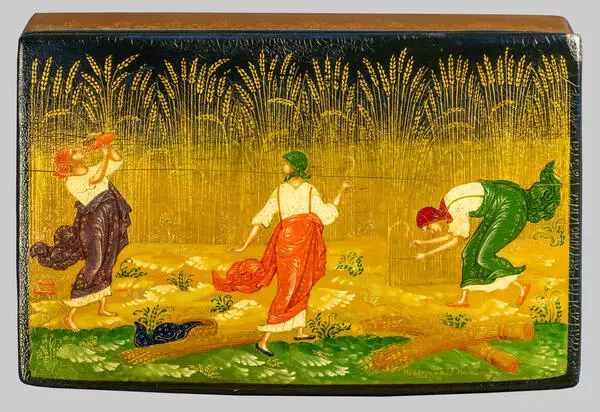Before the Russian Revolution of 1917, Ivan Markichev studied icon painting and took part in restoration of frescoes in churches. He worked in Moscow, in the Trinity Lavra of St. Sergius, Saint Petersburg, Kostroma, Yaroslavl, Kalyazin. Such extensive experience in the field of monumental art shaped his creative style: painting on big walls required the use of generalized imagery and clear compositions. These principles were reflected in his lacquer miniatures.
One of the most powerful compositions in the master’s creative heritage is the “Harvest”. He depicted three female figures united in movement: their gestures look smooth and are reminiscent of some type of dance. For the master, these women represent the ideal of wisdom, beauty and grace of the Russian peasant woman. However, the artist did not simply paint hard peasant work in the fields: he showed the eternal beauty of a woman and Mother Earth herself.
Ivan Markichev created several versions of this composition during his career. For each of them, he worked meticulously with the shape of the object: whether it was a decorative plate, a round or rectangular box. His favorite motif is a textbook example of Palekh miniature.
The late 1920s — early 1930s were the heyday of Palekh art. Ivan Markichev, along with other famous masters, stood at its origins.
The icon painters of Palekh had always been renowned for their miniature icons: icons-menaions (special calendars used by Orthodox Church) with small figures of saints, small hagiographic icons with many scenes on all sides, and compositions with depicted iconostases. This type of art was distinguished by a jeweler’s thoroughness of painting: masters placed a lot of exquisitely painted images on small surfaces. This skill was one of the foundational principles of this local style. Due to these skills, after the revolution, the artists could easily paint tiny boxes for beads or brooches, onto which they could fit many characters.
The former icon painters quickly mastered new skills and applied miniature painting techniques to three-dimensional objects made of papier mâché. The finest gold ornaments was an important feature, as they emphasized the shape of the items and corresponded to the theme of the painting.
The Palekh painters deliberately chose the black background for their works. First, it enhanced the vibrancy of local colors (local color is the natural color of an object without any reflections and impurities: pure red, pure green, and others). Second, such background served as a rhythmic pause in between the individual elements of the painting. Furthermore, due to the lacquered surface, polished to a mirror shine, the black color acquired a special depth.
One of the most powerful compositions in the master’s creative heritage is the “Harvest”. He depicted three female figures united in movement: their gestures look smooth and are reminiscent of some type of dance. For the master, these women represent the ideal of wisdom, beauty and grace of the Russian peasant woman. However, the artist did not simply paint hard peasant work in the fields: he showed the eternal beauty of a woman and Mother Earth herself.
Ivan Markichev created several versions of this composition during his career. For each of them, he worked meticulously with the shape of the object: whether it was a decorative plate, a round or rectangular box. His favorite motif is a textbook example of Palekh miniature.
The late 1920s — early 1930s were the heyday of Palekh art. Ivan Markichev, along with other famous masters, stood at its origins.
The icon painters of Palekh had always been renowned for their miniature icons: icons-menaions (special calendars used by Orthodox Church) with small figures of saints, small hagiographic icons with many scenes on all sides, and compositions with depicted iconostases. This type of art was distinguished by a jeweler’s thoroughness of painting: masters placed a lot of exquisitely painted images on small surfaces. This skill was one of the foundational principles of this local style. Due to these skills, after the revolution, the artists could easily paint tiny boxes for beads or brooches, onto which they could fit many characters.
The former icon painters quickly mastered new skills and applied miniature painting techniques to three-dimensional objects made of papier mâché. The finest gold ornaments was an important feature, as they emphasized the shape of the items and corresponded to the theme of the painting.
The Palekh painters deliberately chose the black background for their works. First, it enhanced the vibrancy of local colors (local color is the natural color of an object without any reflections and impurities: pure red, pure green, and others). Second, such background served as a rhythmic pause in between the individual elements of the painting. Furthermore, due to the lacquered surface, polished to a mirror shine, the black color acquired a special depth.




